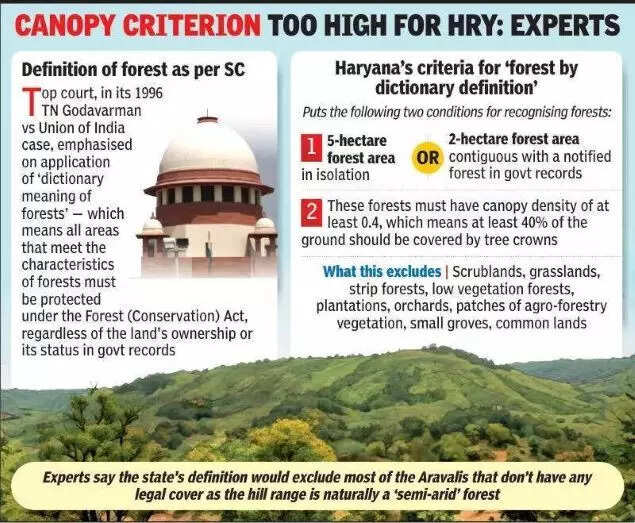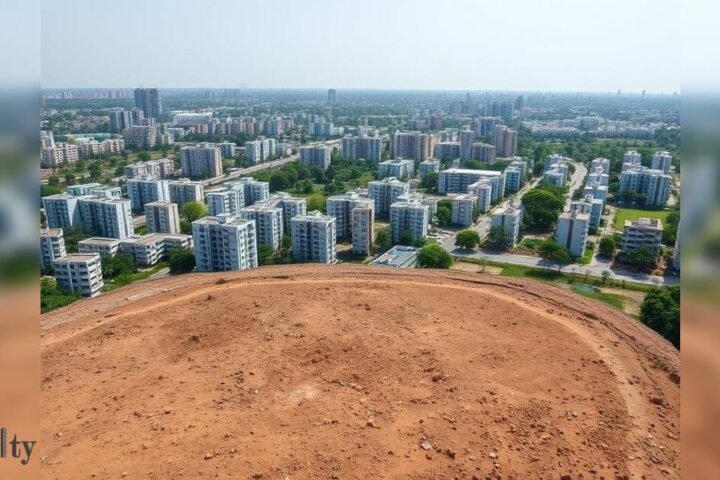
GURUGRAM: Haryana govt has, for the first time, codified what it considers “forest as per dictionary meaning”, laying the foundation for better implementation of environment laws that have been affected by ambiguity about this basic premise.
But the state’s definition is narrower than the frame of reference directed by the Supreme Court in a 1996 ruling and contains riders that could leave out of the definition’s ambit large areas the same environment laws seek to protect.
According to a notification issued on Aug 18 by the state’s forest, environment and wildlife department, land parcels of at least 5 hectares – equivalent to 10 football fields – in isolation or two hectares of forests adjoining notified forests qualify as ‘forest’ if have minimum canopy density of 0.4, or 40% of the land in question.
Effectively, this means that small patches of forests, Aravali hillocks with low density vegetation, scrublands, grasslands and community common lands will not be considered as ‘forests’.
The state’s criteria explicitly exclude linear, compact and agro-forestry plantations, and orchards beyond notified forest areas, regardless of their size or density. Examples of linear plantations are roadside green belts, which are just a few metres wide though these can stretch up to several kilometres. Compact forests are smaller scale areas with dense greenery.

“The Governor of Haryana is pleased to define the expression ‘forest as per dictionary meaning” for the state of Haryana as follows: A patch of land shall be deemed to be forest as per dictionary meaning if it fulfils the following conditions: Firstly, it has a minimum area of 5 hectares, if it is in isolation; and a minimum area of two hectares, if it is in contiguity with govt-notified forests. Secondly, it has a canopy density of 0.4 or more. Provided that, all linear/compact/agro-forestry plantations and orchards situated outside the govt-notified forests shall not be treated as forest under the above definition,” the notification signed by Anand Mohan Sharan, additional chief secretary (environment, forests and wildlife), read.
Haryana’s definition, formed nearly six decades after the state came into existence, is narrower than the principle defined by Supreme Court in its landmark ruling in the 1996 TN Godavarman vs Union of India case.
The top court had said that forests must be recognised according to the ‘dictionary meaning of forest’ — a criterion that means any area with characteristics of forests must be protected under the Forest (Conservation) Act, regardless of the land’s status in govt records.
This concept, which came to be known as ‘deemed forest’, widened the scope of FCA and allowed protection of all such green areas from urbanisation and deforestation.
Experts on Tuesday said the state’s definition would leave out a large chunk of the Aravalis from getting any legal cover.
“This definition doesn’t even consider the ground realities that are unique to the state. The Aravalis are majorly scrub forest and have a canopy density of 10% to 20%. This definition won’t even protect the habitat of Haryana’s state bird black francolin and state animal blackbuck because these species live in grasslands… This will only benefit the builder lobby,” said MD Sinha, retired conservator of forests, Haryana (South).
Others pointed out that Haryana, at just 3.6% of its geographical area, already has the lowest forest cover among all Indian states.
“In the last 15 years, Haryana has been developing six-lane roads in every district, which has led to a decrease in strip forests. 90% of strip forests in Haryana are gone. It has just 5 to 7 block forests, and even those are encroached on. Also, the definition is not practical as Haryana has scrub forest. The five-hectare rule won’t work because there are no large patches of forest land in the state,” said RP Balwan, former conservator of forests, Haryana (South).
The exercise to come up with a definition of forests as per dictionary meaning was ordered by SC, which on March 4 directed all states and Union territories to identify forests to prevent the loss of green cover.
The court’s order came while hearing a clutch of writ petitions that had challenged the central govt’s amendments to the Forest (Conservation) Act.
Supreme Court cited its 2011 Lafarge judgment (linked to a case on environmental approvals for mining in Meghalaya) and told all states/UTs to form expert committees within a month.
Principal chief conservator of forests Vineet Kumar Garg told TOI that the state govt-appointed committees can now begin their work. “The committees will need to survey landscapes, verify canopy cover, apply the five-hectare rule and mark areas for inclusion or exclusion. This process will decide how much of the Aravalis and other open land actually get legal protection under the Forest (Conservation) Act,” Garg said.
Asked about the narrowed definition than the ‘dictionary meaning’, Garg said all states were asked to come up with their own definitions.
“The expert committee under the chairmanship of the chief secretary carefully analysed the definition of other states. Fifteen other states had already adopted a forest definition, which relies on canopy density of 0.4 or more. Haryana also decided to go with the same. This is for areas outside of (notified) forests. So, this definition will not reduce areas,” the PCCF said.
Though Haryana is home to 1 lakh hectares of the Aravali hills, more than half of this range (55,000 hectares) in the state has no protection under FCA.
Much of this also has to do with the ownership oddity in Haryana, where Aravali land was never given the ‘forest’ tag by the state. Most of Aravali area is under the ambit of the revenue department instead of the forest department.
The only Aravali lands protected in the state are because of court rulings, such as the special sections 4 and 5 of Punjab Land Preservation Act (PLPA), 1990, and the Aravali Notification of 1992.
Protecting the Aravalis is critical not just for the state, but most of north-west India. The ancient hill range is the only barrier that stops the Thar desert from expanding towards the plains. It is also home to a rich and unique diversity of flora and fauna, among them endangered species such as leopards, Indian pangolins and white-rumped vultures.
Forest analyst Chetan Agarwal, too, bashed the state’s definition, saying that the Aravali regions receive less rainfall and the forests have adapted to thorny and dry-deciduous vegetation because of it.
“It is a pity that Haryana has blindly followed the lead of states like Goa in choosing a minimum threshold of 40% forest canopy cover to identify an area as a deemed forest. At least in the Aravalli hills, open forest with 10%-40% canopy cover and scrub (0-10% cover) categories should have been treated as forest as per dictionary meaning. This decision opens up the Aravalis to the ravages of urbanisation and mining,” he said.











